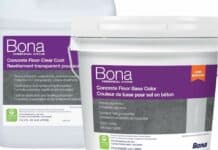By Aaron Hartung
Maintenance protects your investment, plain and simple. As any facility manager knows, renovations are expensive. And proper maintenance pays dividends when compared to ripping and replacing every five years. Flooring is no exception. Your floor endures foot traffic, spills and the weight of equipment and furniture on a daily basis. You need to have a flooring maintenance plan in place to extend the life of the flooring system and keep the manufacturer’s warranty intact.
Here we’ll walk you through how to work with a flooring contractor to develop a holistic floor maintenance plan for your facility. We’ll also give you industry resources to learn how to clean your facility’s carpet, vinyl tile and ceramic tile floors.
 Developing A Flooring Maintenance Plan
Developing A Flooring Maintenance Plan
The key to any flooring maintenance plan is to take a proactive, holistic approach instead of a reactive, as-needed one. This means implementing a plan right after a flooring system is installed — not waiting until the flooring is damaged to schedule a restorative cleaning.
It typically doesn’t cost anything to have a flooring contractor build a custom maintenance plan for your facility because their contract is for the actual maintenance work. So there’s no reason not to enlist the experts. And a flooring contractor will add value by tailoring your daily cleaning and periodic maintenance procedures to your facility’s budget — and how your facility is actually used.
They’ll begin by sitting down with the building owner or facility manager to read the floor plan, asking:
- What’s your maintenance budget?
- How is each area of your facility used?
- What are the manufacturer-recommended maintenance procedures for each product in your facility?
The answers to each will affect your maintenance plan. Consider a flooring product with manufacturer guidelines that call for weekly deep cleans. That frequency level might be cost-prohibitive for a facility with a lower maintenance budget. To maximize the power of your budget and prevent premature flooring failure, it makes sense to break out maintenance frequency by traffic patterns.
Break out facility floorplan by product and traffic level
Armed with your facility floorplan and the answers to the above questions, your contractor will get to work. They’ll label each room on your floorplan by product and traffic level (low, medium, high). Working within the constraints of your budget, they’ll develop frequencies for routine (vacuuming, spot cleaning) and periodic (interim deep cleaning) maintenance based on each traffic level.
You might, for instance, have your in-house janitorial staff take care of routine maintenance once a day for high-traffic areas (e.g., lobbies, copy rooms, main hallways) and only three times a week for low-traffic areas (e.g., conference rooms, offices). And your flooring contractor might take care of periodic maintenance activities monthly for high-traffic areas and semi-annually for low-traffic areas.
The specific maintenance activities required will vary widely by product category and manufacturer. For example, a luxury vinyl tile (LVT) product from one manufacturer might have slightly different manufacturer-recommended maintenance instructions than a similar product from another manufacturer. The differences tend to lie in the proprietary cleaning chemicals and equipment recommended, not the general process.
We’ll focus on maintenance best practices for four of the most prevalent flooring systems in commercial facilities: Commercial carpet, LVT, VCT and ceramic tile.
How to clean commercial carpet
Carpet tiles and broadloom tiles (this article explains the difference) is the most popular flooring category, comprising 45.4% of overall floor sales in the U.S (reported in the July 2018 issue of Floor Covering Weekly).
Routine maintenance. Vacuuming is the most important part of carpet maintenance — as much as 85% of dirt can be removed through vacuuming alone. And when excess dirt is present in carpet, it begins to abrade the fibers, matte the carpeting and create visible traffic lanes. Use only vacuum cleaners earning Gold-Level Seal of Approval from the Carpet and Rug Institute (CRI). When spills, stains and soiling occur, promptly clean the area with the spot cleaner recommended by the manufacturer.
Periodic maintenance. Encapsulation, where the carpet is vacuumed, sprayed with a cleaning agent, agitated and then vacuumed again, is required on an interim basis between deep cleanings. Hot water extraction, where the carpet is vacuumed, sprayed, agitated and then rinsed with clean water and then dried, is required every few encapsulation treatments to deep clean your carpets. Videos of both encapsulation and hot water extraction can be found here. It’s important to have all periodic maintenance performed by a CRI-approved maintenance company to ensure your manufacturer’s warranty remains intact.
If you’d like to learn more about commercial carpet maintenance, below are links several manufacturer checklists:
https://bit.ly/2U5Ei2J
https://bit.ly/2Ywd3fW
https://bit.ly/2TYDkoK
 How to clean commercial LVT
How to clean commercial LVT
LVT has quickly established itself as a leader in the commercial vinyl flooring category across many markets. Hospitals, schools and corporate offices are switching from vinyl composition tile (VCT) to this low-maintenance, no-polish alternative. And for one school, the switch from VCT to LVT saved them $77,941 in just 10 years.
Routine maintenance. It’s recommended to vacuum and dust mop LVT regularly to prevent dirt from grinding into the surface. Spills and spots should be mopped up immediately using a neutral cleaner diluted to the recommended level. Wet mopping can be done daily, weekly or as needed depending on the traffic or soil level of the area.
Periodic maintenance . At a frequency recommended by your flooring contractor, LVT should be cleaned using a neutral cleaner and auto scrubber and then rinsed with water. This can be followed by spray buffing if required to remove scuffs. Routine maintenance activities must be performed before periodic cleaning to prevent the dirt from being ground into the flooring surface by the scrubber.
Here are several maintenance guides from different manufacturers if you’d like to take a deeper look at how to clean and maintain commercial vinyl tile floors.
https://bit.ly/2V0JIIC
https://bit.ly/2Ugg5WC
https://bit.ly/2HW14T5
How to clean commercial VCT
For years, VCT was the leader in commercial vinyl flooring. It’s a budget-friendly, abrasion-resistant, durable material commonly used in warehouses, schools and cafeterias. But it comes with a major downside — it’s very high maintenance. And with the rise of LVT, though, many facilities are switching to avoid the tedious, high-cost maintenance of VCT.
Routine maintenance . The floor should be vacuumed and mopped regularly with the manufacturer-recommended neutral cleaner to prevent the build-up of debris causing abrasions to the tile’s protective polish.
Periodic maintenance. The floor must be machine scrubbed periodically and, if needed, additional coats of polish should be added. Every so often, restorative maintenance will be required to ensure there is a sufficient protective barrier above the porous tile. This requires chemically stripping and reapplying the tile’s floor polish. As with other flooring types, all periodic and restorative maintenance must be performed after routine maintenance procedures.
For a deeper understanding of VCT cleaning and maintenance best practices, check out this guide.
How to clean commercial ceramic tile floors
Ceramic tiles open up a plethora of design possibilities: Mosaic patterns, vibrant colors, custom-cut designs. They’re also high-performance and low-maintenance with a long list of commercial applications: Lobbies, bathrooms, high-end offices and more. And although LVT has taken the market by storm, offering a cost-effective alternative to tile, ceramic tile still accounts for more than 14% of flooring sold in the U.S. (reported in the July 2018 issue of Floor Covering Weekly).
Routine maintenance. Most dirt and soil can be vacuumed and cleaned with a neutral cleaner. Spots, paints, oils and soap can be cleaned with the spot cleaner (there is a spot cleaning matrix on page 492 of this guide) recommended by the manufacturer. It’s important to note that any soil left on the floor may abrade the tile surface and liquids will change the slip resistance of the tile and pose a safety risk.
Periodic maintenance . The tile will have to be deep cleaned periodically to remove mineral deposits or mold using the manufacturer-recommended cleaners. And even ceramic tile installed with 100% epoxy grout will need to be deep cleaned occasionally to remove build-up of dirt, grease soap or other types of soil and prevent grout discoloration.
Check out these maintenance checklists to learn more about how to clean commercial tile floors.
https://bit.ly/2UgbHqz
https://bit.ly/2TDTAGH
The Importance Of A Holistic Look At Flooring Maintenance
This is only the tip of the iceberg when it comes to facility flooring maintenance. There are dozens of manufacturers, hundreds of products and scores of facility types — which is why every maintenance program needs to be designed on a case by case basis.
A myriad of factors — flooring product, budget, traffic level, facility environment — affect your facility’s maintenance needs. Something as simple as buying walk-off mats to place near sinks and coffee pots in your breakroom or cleaning the sidewalks right outside your front door can prevent damage to your flooring and save thousands in the long run.
That’s why it’s important to work with a maintenance professional with a thorough understanding of flooring to create your program. They’ll look at all factors collectively, stretching your maintenance budget as far as possible while still protecting your flooring system from failure.
 Hartung is the marketing manager at Spectra Contract Flooring, the largest commercial flooring contractor in the United States. Spectra Contract Flooring can help facility managers select the right low-maintenance flooring products, install them. and maintain them. With more than 400,000 commercial flooring projects done, the company has the experience and expertise to create a customized maintenance plan built around the customer’s budget.
Hartung is the marketing manager at Spectra Contract Flooring, the largest commercial flooring contractor in the United States. Spectra Contract Flooring can help facility managers select the right low-maintenance flooring products, install them. and maintain them. With more than 400,000 commercial flooring projects done, the company has the experience and expertise to create a customized maintenance plan built around the customer’s budget.
















 Developing A Flooring Maintenance Plan
Developing A Flooring Maintenance Plan



![[VIDEO] Collect Asset Data at the Speed of Walking a Building](https://facilityexecutive.com/wp-content/uploads/2024/02/maxresdefault-324x160.jpg)